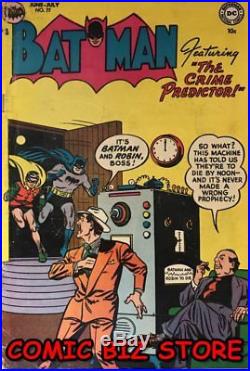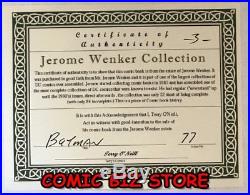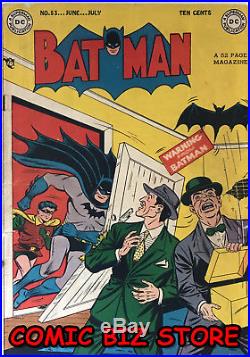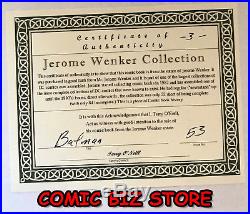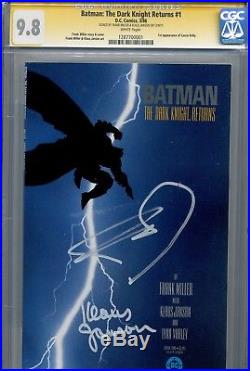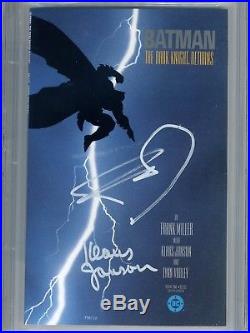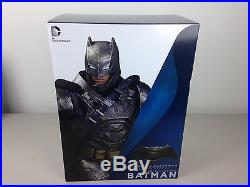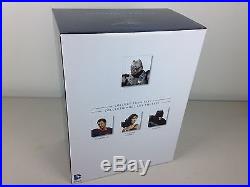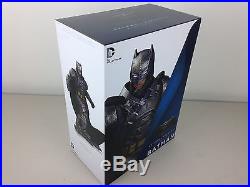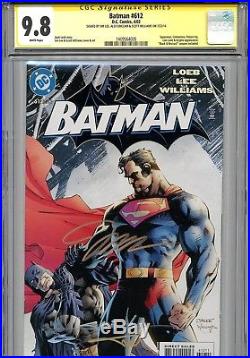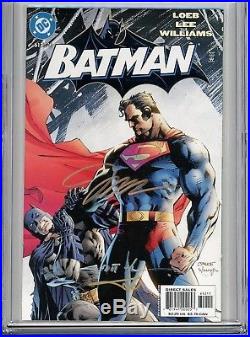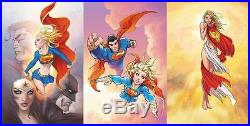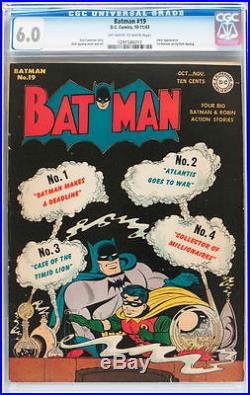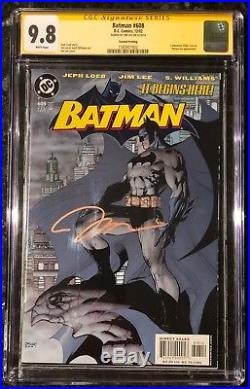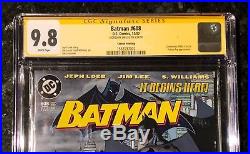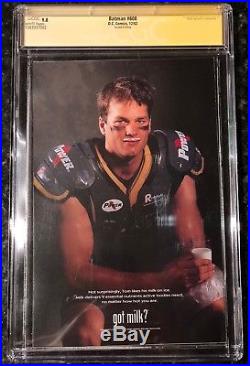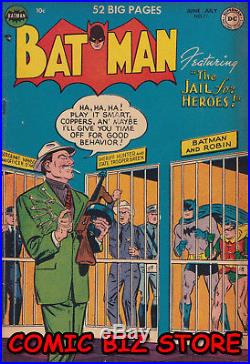

A n o t h e r g r e a t l i s t i n g f r o m. Britain’s favourite comic book dealer! A highly collectable Golden Age DC Comic. This comic has been strictly graded as a complete solid, strong, flat VERY GOOD (vg) (4.0) copy with bright cover colours and supple creamy white pages. It ships bagged & boarded. See’Guide to the way we grade… Sign up to our newsletter in our shop to be alerted to the new listings. Our grading standards are based on the standards laid out in the Overstreet Grading Guide with additional experience gained from our 30+ years in the comic industry. We closely monitor and calibrate our staff to maintain adherence to our extremely high standards. However, grading is an inherently subjective process and there will always be small differences in opinion. Even professional grading services like CGC acknowledge that the same book may not always receive the same grade if it is submitted for grading more than once. The basic grading scale , also known as letter grades, uses the grades from Near Mint (highest) to Poor (lowest). The ten-point grading scale assigns grades ranging from 10.0 (highest – although, in our opinion, doesn’t exist) down to 0.5 (lowest). 10.0 GM Gem Mint. 9.9 M Mint. 9.8 NM/M Near Mint/Mint. 9.6 NM+ Near Mint+. 9.4 NM Near Mint. 9.2 NM- Near Mint. 9.0 VF/NM Very Fine/Near Mint. 8.5 VF+ Very Fine+. 8.0 VF Very Fine. 7.5 VF- Very Fine. 7.0 FN/VF Fine/Very Fine. 6.5 FN+ Fine+. 6.0 FN Fine. 5.5 FN- Fine. 5.0 VG/FN Very Good/Fine. 4.5 VG+ Very Good+. 4.0 VG Very Good. 3.5 VG- Very Good. 3.0 GD/VG Good/Very Good. 2.5 GD+ Good+. 2.0 GD Good. 1.8 GD- Good. 1.5 FR/GD Fair/Good. 1.0 FR Fair. 0.5 PR Poor. Most comics graded using the ten-point grading scale also have cover scans, so when you’re considering purchasing a comic you can see the front (and sometimes back) cover scans of the exact comic being offered. For cheaper comics graded on the basic grading scale, we show you a stock image of what that issue’s cover looks like, but we don’t scan the exact book being offered. Additionally, some comics are “slabbed” by CGC. This comic grading service will grade a comic and then seal the comic in a hard plastic case that displays the assigned grade. This grading service assigns grades on the same ten-point grading scale used by Comic Biz You can easily identify a slabbed comic because the grades will include the name of the grading service, such as “CGC 9.4″. A comic that has not been slabbed is sometimes referred to as a “raw” comic, which just means a regular comic not encased in a plastic slab. We will gladly work out a solution that meets your needs and concerns. When reviewing the possible defects a comic may have as shown below for the various grades, please keep in mind that while a single defect may not reduce a comic’s grade, that defect if repeated and/or combined with other accumulated defects, may push the grade down by one or more grades. Near Mint (NM) condition. A nearly perfect copy that looks brand new with only a few very minor defects. Acceptable minor defects on a NM copy include: A very small amount of spine stresses without colour breaks, very minor instances of denting (two or three at most), slight corner blunting, and minor (less than 1/8) bends without colour breaks. On the ten-point grading scale, a lower grade like 9.2 will allow these defects in a greater quantity and degree than a higher grade like 9.8, which sometimes may have no discernable defects at all. We do not assign the grades 9.9 and 10.0 to any unslabbed “raw” comics. You will only see these ultra-high grades on comics slabbed by one of the grading services. There is such a small degree of separation between the grades 9.8, 9.9, and 10.0 that even the most experienced comic graders may disagree on which of these three grades to assign to an apparently flawless comic, so the highest grade we will assign to a comic is 9.8. Very Fine (VF) condition. A VF copy has minor defects, but is in overall excellent condition. Most well-kept modern comics (especially if they have been read) fall into this grade. Acceptable defects on a VF are minor and include: Minor corner wear, a light accumulation of spine stress that may include colour-break, a light accumulation of dents, and bends or folds less than 1/4 (note that on a VF copy, some colour-break is allowed in a bend/fold). A comic in FN condition is considered “above average” but still displays some wear. In general, the eye appeal is somewhat reduced due to either an accumulation of minor defects or one or two moderate defects. Acceptable defects on a FN copy include: Slight spine roll, a moderate accumulation of spine stresses that may break colour, a spine split of less than 1/2, minor water spotting or residue (less than the size of a dime), an impacted corner, and moderate foxing. Very Good (VG) condition. A comic in VG condition shows some significant wear, but has not accumulated enough total defects to reduce eye appeal to the point that it is not a desirable copy. A VG copy may have an accumulation of minor defects or one or two major ones. Acceptable defects on a VG copy include: Spine roll, 1/2″ to 1″ spine splits or other tears, a cover or centrefold that is detached at one staple, discoloration due to oxidation, and a moderate accumulation of water damage or staining. A GD copy has major defects, but is still complete and readable. A GD copy will have a significant amount of damage, usually an accumulation of smaller defects punctuated with some major defects. Acceptable defects on a GD copy include: A vertical book-length crease, 1.5″-2″ spine split, cover or centrefold completely detached, major tears, heavy discoloration/brittleness due to oxidation, heavy amounts of staining, residue, and water damage. A FR is the lowest grade a comic book can receive as long as the story and art are complete. A FR copy will have virtually no eye appeal and will display major damage. A comic book in FR condition may have non-story elements such as coupons, ad pages, or Marvel Value Stamps cut or torn out of the book. Types of damage that place a comic in FR range include: A spine split of up to 2/3 the length of the book, a missing back cover provided the front cover is still attached, severe water damage or residue damage, mould, and paper deterioration due to oxidation. Comic books in PR condition may be missing up to 4 pages (two spreads) of story pages or display severe damage that affects the readability of the book. A Quick Note On Digital Codes. Publishers may choose to include digital content codes in their comics. Except where noted, we cannot guarantee that comics we sell will contain valid, unused, unexpired digital codes, and we can take no responsibility if a publisher chooses not to allow you to redeem such a code. Additionally, reasonable efforts to redeem this content (in particular, carefully removing a sticker covering codes) are not considered to reduce the grade we would assign the book. Glossary of Grading Terms. When part of a comic is curved, interrupting the flat, smooth cover surface. Bends WILL NOT show distinct lines (see also crease/fold). A small horizontal rip in a comic’s cover that can usually be seen on both the front and the back. These are always found along the spine and should be graded like spine stress if they are shorter than 1/4. Damage caused by the gnawing of rodents or insects (usually). Results in multi-page paper loss with jagged edges. Bubbling on a cover’s surface (typically a printing defect). A fold that causes ink removal/colour break, usually resulting in a white line (see bend/fold). Indentations or dimpling (usually in the cover) that don’t penetrate the paper or remove any gloss, but do interrupt the smooth, flat surface. Technically a printing defect, double-cover books had an extra copy of the cover stapled on during manufacturing. This protective extra cover can be a boon, as these books are graded by the condition of the innermost cover. When a comic has been stored in a stack at some point in its life, any portions of the cover that weren’t covered up by the adjacent books have been exposed to environmental air, light, and settling dust particles, sometimes creating lines of discoloration along the edges. Finger oils can usually be wiped away, but fingerprints are irreversible. A method of examining a comic that uses its natural gloss and light (glare) to help you see imperfections in its surface, like denting. Linear dents in paper that have distinct lines, but DO NOT break colour (see also bend/crease). Bacterial or fungal growth in the paper of a comic (usually the cover) that presents in brownish discoloured clusters or spots. The shiny surface finish of a comic. The damage left behind when a comic has been exposed to moisture (directly or environmentally). Water damage often presents with staining and/or a stiff or swollen feel to the paper. Look for lines of demarcation. When the surface of a comic has been compromised. This can be the result of heavy scuffing/abrasion, accidental tape pull, or the chemical reactions caused by some kinds of moisture damage. Paper quality refers to the coloration and structural integrity of a comic’s cover and interior pages. We do give some leeway on pre-1980s comics, but when environmental conditions have caused the paper to oxidize and/or deteriorate significantly, the decrease in eye appeal and paper strength will bring a book’s grade down. Generally, paper quality will not be a concern for most modern (post-1980) comics. A flaw caused in the printing process. Examples: paper wrinkling, mis-cut edges, mis-folded or mis-wrapped spine, untrimmed pages/corners, off-registered colour, colour artefacts, off-cantered trimming, mis-folded or unbound pages, missing staples. A vertical cover crease near the staples that runs (generally) parallel to the spine, caused by bending the cover over the staples or just too far to the left. Squarebound books get these very easily. Any attempt (professional or amateur) to enhance the appearance of an aging or damaged comic book. Dry pressing/cleaning and the simple addition of tape repairs are not considered restoration, but the following techniques are: recoloring/color touch, adding missing paper, stain/ink/dirt/tape removal, whitening, chemical pressing, staple replacement, trimming, re- glossing, married pages, etc. Restored comics generally carry lower value than their unaltered counterparts. A light paper abrasion that may or may not break colour, but interrupts the surface gloss of the book. Its effect on grading is determined by severity. Substances or residue on the surface of a comic. Most commonly found in white spaces. Residue is a more severe form of soiling. A spine stress that has devolved into a tear (usually through multiple wraps). Spine breaks greatly decrease the spine’s structural integrity and are often found close to the staples. A condition where the left edge of a comic curves toward the front or back, caused by folding back each page as the comic was read. Also usually results in page fanning. A clean, even separation at the spine fold, commonly above or below the staple, but can occur anywhere along the spine length. A small crimp/fold perpendicular to the spine, usually less than 1/4 long. When a wrap has come completely loose from a staple and is no longer bound to the comic in that area. When staple rust has moved onto the surrounding paper, causing staining. When one side of a cover has torn right next to the staple, but is still attached by the slip of paper beneath the staple. If not handled carefully, a popped staple can lead to a detached staple. Literally, rust on the staple. A single sheet of paper folded to form four pages of a story. Most modern comics have eight wraps, plus the cover but there are exceptions! Writing can be found on/in comics in many forms, and downgrades are based on severity. Common things you’ll see. Minor initial or date markings (do not affect grade except in the highest range). Names written on covers or in margins. Interior puzzles filled out. Markings/colouring over interior art. Writing indentations, in which no ink or pencil has touched the comic, but it has been used as a writing surface, so you can see rough areas where the writing dented in. The item “BATMAN #71 (1952) DC GOLDEN AGE 1ST PRINTING VG 4.0 BAGGED & BOARDED” is in sale since Thursday, August 23, 2018. This item is in the category “Books, Comics & Magazines\Comics\US Comics\1956-1969 (Silver Age)\Superman”. The seller is “comic-biz-store” and is located in London. This item can be shipped worldwide.
- Modified Item: No
- Character(s)/ Title: SUPERBOY, GREEN ARROW, AQUAMAN
- Publisher: DC Comics
- Age: Golden Age (1938 – 1955)
- Genre: Superheroes
- Features: Ships Bagged & Boarded


